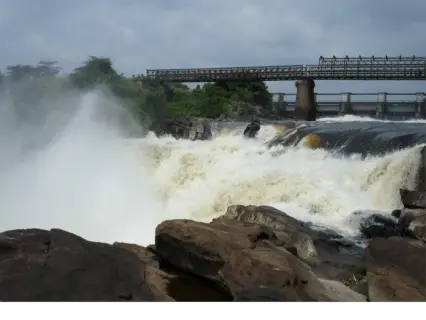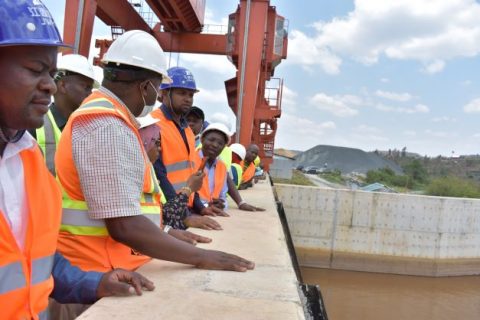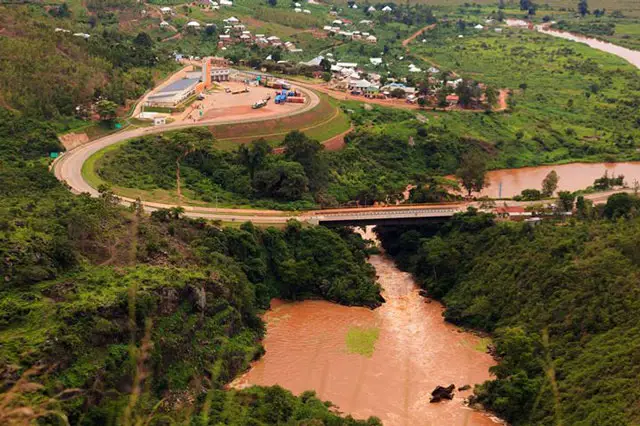Residents of KAGERA and other Tanzanians have reason to be happy as the Regional Rusumo Falls Hydroelectric Project, eagerly awaited, has reached 99 percent completion and is set to be unveiled soon.
The status of the project was revealed by Engineer Godlove Mathayo, Kagera Regional Manager for Tanzania Electricity Supply Company (TANESCO). Mathayo expressed his confidence that the hydropower project will boost socio-economic growth, and strengthen regional cooperation and partnerships.
Moreover, he said, it will promote peace in the East African region as well as tackle the severe power deficit that the three nations are currently experiencing, which negatively impacts their economies.
Regional Rusumo Falls Hydroelectric Project (RRFHP) overview
Rusumo Hydroelectric Power Plant is a regional hydropower project jointly developed by the Governments of Burundi, Rwanda, and Tanzania through the commonly owned, Rusumo Power Company (RPCL).
With a planned capacity installation of 80 megawatts or rather 110,000 hp, the power plant is being constructed at Rusumo Falls on the Kagera River, along Rwanda’s border with Tanzania and approximately 2 kilometers downstream of the tri-point where the two countries share a common border with Burundi.
Scope of the project
The project mainly involves the construction of a concrete gated dam with a height of 12m and a spillway structure with three water passages equipped with three radial gates, each measuring 9m wide and 9.5m-high.
A water intake and headrace tunnel measuring 11m-wide and 14m-high and featuring a shotcrete and rock bolts support system will also be constructed as well as a concrete-lined vertical surge shaft with a diameter of 8m and a surge chamber with a diameter of 41m. The plant will also include a 260m-long diversion canal with a width of 17m and a 250m-long tailrace canal with a width of 40m.
On the southern side of the Kagera Riverbank in Tanzania, will be the powerhouse of the plant which includes three vertical axes Kaplan turbines and three 30MW generators with 12kV output voltage, and on the northern side of the Kagera Riverbank in Rwanda will be a 220kV substation switchyard.
The project also features the construction of 220kV transmission lines from Rusumo Falls to; 1. Gitega in Burundi (161km), 2. Nyakanazi in Tanzania (98km) and 3. Shango and Bugesera in Rwanda (119km).
Expectations for the project
The predicted annual generation is approximately 500GWhr with a load factor of 63%.
The generated electricity will be equally shared among the three countries each benefiting from approximately 26MW directly connected to the national grid through 220kV transmission lines from Rusumo Falls to; 1. Gitega in Burundi (161km), 2. Nyakanazi in Tanzania (98km) and 3. Shango and Bugesera in Rwanda (119km).
The project’s overall objective is to increase the supply of electricity to the national grids of Rwanda, Tanzania, and Burundi. By so doing, the project will have addressed the acute shortage of electricity experienced by the three Kagera sub-region countries of Burundi, Rwanda, and Tanzania which is negatively affecting their economies and the livelihoods of their citizens.
The project will also enhance regional cooperation, and peacebuilding, support the sustainable management of the Kagera river basin, and promote growth and poverty reduction whilst managing environmental aspects.
Reported earlier
In February 2012, the Republic of Burundi, the Republic of Rwanda, and the United Republic of Tanzania signed an agreement for the development of the regional hydropower project.
In August 2013, the World Bank Executive Board approved USD$ 340M for the construction of the 80MW power plant. The African Development Bank (AfDB) also committed USD$ 88.24M towards the construction of the three transmission lines to Burundi, Rwanda, and Tanzania.
In September 2013, the Regional Rusumo Falls Project – Council of Ministers (COM) signed the Shareholders Agreement and the Implementation Agreement in Bukoba, Tanzania. This paved way for the implementation of project activities beginning with the resettlement and compensation process.
Sep 2015
Construction of Rusumo Falls Hydropower Project along Rwanda-Tanzania border to begin
Construction works of the 80MW Rusumo Falls hydropower project are set to begin next year. The announcement comes after the families who were living in the area were relocated. “Holding other factors constant, the civil works should start in the first quarter of 2016,” said William Katete, the Communications Officer of the Regional Rusumo Falls Hydroelectric Project.
The governments of Burundi, Rwanda, and Tanzania jointly agreed on this project which is fully funded by the World Bank and African Development Bank (AFDB). World Bank contributed US$ 340m, while US$130m for the construction of the transmission lines and substations was obtained from the African Development Bank and extended to the three countries.
The costs of the construction project which total US$ 470m will be constructed in two phases where the first phase will involve the construction of the power plant and the second will entail the installation of high voltage transmission lines. The transmission lines are anticipated to transport both imported and exported power from Rwanda, Burundi, and Tanzania once the plant is complete.
The tendering process to select firms to construct the dam is now in the pre-qualification stage with commissioning expected to be done in 2019. Each of the three countries will receive 26.6MW of power.
The power station is on the Kagera River, along Rwanda’s international border with the Republic of Tanzania and approximately 2 km downstream of the tripoint, where the two countries share a common border with the Republic of Burundi.

Nov 2016
Construction of the Rusumo hydropower project In Uganda underway
Two contracts, worth US $75M have been signed for the preliminary construction of the Regional Rusumo Falls Hydroelectric Project.
The primary contract was signed between Rusumo Power Company Limited (RPCL), and a conglomerate of contractors, including CGCOC Group Ltd – Jiangxi Water and Hydropower Construction Company Ltd Joint Venture (CGCOC – JWHC JV). The Nile Equatorial Lakes Subsidiary Action Programme Coordination Unit signed on behalf of Rusumo Power Company Limited.
The first contract covers civil works, including delivery and installation of hydro-mechanical equipment (the design, dam, waterways, power station, and other related civil engineering works. The second contract was signed between Rusumo Power Company Limited and a conglomerate of companies, such as German company Rusumo Falls Andritz Hydro GmbH and Indian company Andritz Hydro PVT Ltd, to handle mechanical and electrical works for energy production.
Eng. Elicad Elly Nyabeeya, Nile Equatorial Lakes Subsidiary Action Programme Coordination Unit regional coordinator, said they were pleased with the measure to progress the project.
On 30 March 2017, the ground-breaking ceremony for the project was held at Ngara, in Tanzanian territory.
April 2017
The Rusumo Falls HEP project was officially unveiled at a ceremony
Rusumo Falls HEP project which was unveiled last week is inclusive of the construction of transmission lines at a cost of $121 million to link the national grids of Tanzania, Burundi, and Rwanda, each with a share of 26.6MW from the 80MW that the hydropower plant will generate.
Rusumo Falls HEP project and transmission lines, whose completion is scheduled for 2020, are among the solutions to power shortages facing the three countries, playing a significant role in boosting electricity trade not only in the region but also in Africa as a whole through interconnection routes from North and South Africa power pools.
Present at the unveiling ceremony of the Rusumo Falls HEP project, Tanzanian energy, and minerals minister, Sospeter Muhongo revealed that access to electricity in Tanzania has more than doubled, from less than 30% to 67.3% during the past decade. He further added that access to power in rural areas also improved from just 2% in 2007 to 47.5% at present.
In the interim, the World Bank country director for Tanzania, Burundi, Malawi, and Somalia, Bella Bird, said that the project will boost the installed electricity capacity of the respective countries at cheaper costs. The electricity to be generated from Rusumo will be charged at 6 US cents.
According to Bird, this will aid in reducing the costs which have been incurred from other sources like fossil fuels. She also stated that the share of energy generated is set to improve Burundi’s installed capacity by almost 50% as per reports. Bird expressed delight that the regional project will provide a greener source of energy for the three countries and broaden social and economic uplift to the people.
Also speaking at the ceremony, Rwanda’s minister for infrastructure James Musoni, instructed the contractors undertaking the project to adhere to quality and timely completion of the scheme.
In June 2018, the construction of the river diversion works, which is a part of the construction of the cofferdam, was concluded, and by the end of June 2018, the civil works contractor had commenced.
Feb 2019
US $468m Rusumo hydropower plant in Rwanda to be complete soon

The Rusomo hydropower plant under construction on the Rusumo Falls at the border of Rwanda and Tanzania is expected to be complete by 2020.
Amb. Claver Gatete, Rwanda’s minister for infrastructure affirmed that the deadline that is set would be met since construction works are on track and the 80MW project that is expected to benefit millions of people in Rwanda, Tanzania and Burundi is on track.
July 2019
US $340m Rusumo Hydroelectric plant 47% complete

Construction of the US $340m Rusumo Hydroelectric Project located at the border of Rwanda and Tanzania is 47% complete. The declaration was made by Rwandan Minister for Infrastructure, Amb. Claver Gatete and Tanzanian Minister for Energy, Dr. Medard Kalemani, during a visit to the project site.
“We have seen that the works on the dam are at good progress when compared to how it was last time, and at a tunnel that will lead the water to turbines, we have seen that they have managed to overcome the challenges that had occurred, and the basic works on the powerhouse have already been finished; the electro-mechanical activities are going to start,” said Claver Gatete.
50% of the project’s work was complete in October 2019. This was based on the overall work done by the Civil Contractor and Electromechanical Contractor, particularly within the intake structure, spillway structure, HRT works, powerhouse construction, and hydro-mechanical design, equipment, and installations.
Jan 2020
Rusumo hydroelectric power project in Tanzania is 59% complete
The construction of the Rusumo Hydroelectric Power Station to generate 80MW has now reached 59% compared to 32% in June last year.
The revelations were made by the outgoing chairman of Energy Ministers from Tanzania, Burundi, and Rwanda, Tanzanian Minister for Energy, Dr. Medard Kalemani while briefing the media on the 11th meeting of ministers. “After inspection, my fellow energy ministers and I were satisfied with the construction progress,” said the minister.
Dr. Kalemani noted that a team of ministers from the three East African countries – Tanzania, Rwanda, and Burundi – rejected the contractor’s request to extend the project period. “We have directed the contractor and a team of supervisors to complete the project in February this year,” he said.
Dr. Kalemani mentioned that the contractor’s reasons for the extension of time were due to complaints from residents near the project site. He said Rusumo residents had lodged complaints with the contractor over blasts while implementing the project, so a proper assessment needed to be done.
Dr. Kalemani noted that they directed the contractor to submit the request to the team of ministers with clear reasons for the time extension and that compensation should start for the residents to relocate and pave the way for project implementation.

In March 2020 the project was reportedly 62 % complete for both CP1 (Civil Contractor) and CP2 (Electromechanical Contractor). The Powerhouse area construction was being readied to accept water passage steel and a temporary tailrace wall and ramp construction were underway – aiding in steel liner installations.
At the Power Intake, the gantry erection continued as well as the spillway radial gate and operator line assembly, including the placement of concrete with two spillway decks. River diversion guide wall work was also progressing.
The Headrace Tunnel (HRT) works including full-scale drilling and blasting and pilot blast had been completed and the Switchyard concreting for the gantry tower and shunt reactor bases continued as well as installations of tower anchor.
Construction of permanent residential buildings at the Powerhouse had been fully completed.
In June 2020 with permanent diversion of the water through the spillway structure with the power intake stop logs securely in position, protecting the headrace tunnel from flowing river conditions, and three out of four spillway radial gates locked open, water could safely move downriver.
The second phase of cofferdam construction began the same month driving the closure from Tanzania towards Rwanda, upon which a second smaller cofferdam was constructed, thereby blocking river waters from entering the dry construction area where a short and a long gravity dam, and the fourth spillway bay would be constructed.
As of February 2021, the overall progress of the project was 73.3%. The CP1 civil contractor continued working inside the phase two cofferdam with the dam now at crest level, and work continued within the 4th spillway bay.
Excavation of the tunnel header was progressing with only 96 meters remaining until the header is open completely from end to end of the HRT. Works were also advancing at the administration building, residential camp, and switchyard.
The CP2 contractor on the other hand continued to work in the powerhouse with the assembly of water passage steel in Units 1 and 2, and overhead traveling crane installation within the service bay. The original gantry tower and beam work at the switchyard was 100% completed at the time.

April 2021
Rusumo Hydroelectric Power Project to be operational by year-end
During the 6th Nile Basin Development Forum, Alloyce Oduor, the Power Engineer at the Nile Equatorial Lakes Subsidiary Action Program (NELSAP) disclosed that one unit of the 80MW Regional Rusumo Hydroelectric Power Project could be operational by the end of 2021.
NELSAP is one of the investment programs under the Nile Basin Initiative (NBI) mandated to facilitate transformative regional transboundary cooperative projects or/and in-country projects with regional impact related to the common use of the Nile Basin water resources.
It focuses on hydropower investment projects and regional power transmission interconnections as well as water resources management and development projects.
In June 2021, the overall Project implementation status had hit 80% with a target of 1st power (one unit) planned for December 2021. The dam was planned to be wet in September 2021.
At the time, the civil contractor was expected to complete his work in February 2022 with site restoration and cleaning to follow 2022. The electromechanical contractor on the other hand had achieved 74% progress.
The headrace tunnel breakthrough happened on 12th June 2021.
On 12 September 2021, the Tanzania Parliamentary Committee for Energy and Minerals led by Dr. Medard Kalemani, Tanzania Minister of Energy and Member Council of Ministers for the Rusumo Project visited the Regional Rusumo Falls Hydroelectric Project.
NELSAP and RPCL Management welcomed the delegation and escorted them to the power intake and dam and exhibited the powerhouse. After the tour, the committee expressed satisfaction with the progress made so far (87 percent) in the overall execution of the project.

Aug 2022
Regional Rusumo Falls Hydroelectric Project 95% Complete
According to an announcement made recently, the Regional Rusumo Falls Hydroelectric Project (RRFHP) is 95 percent complete and will be concluded in November of this year. The information was revealed during an event where Tanzania’s Energy Minister, Mr. January Makamba, was to receive the project’s chairmanship.
For the duration of his one-year tenure in the position, Mr. Makamba will be in charge of setting the agenda for and communicating to his fellow ministers on the project status. He will also be in charge of coordinating and leading parallel meetings.
Mr. Makamba claimed that the project had been the vision of the leaders of the three countries since the 1960s.
Rusumo Falls Hydroelectric Project to be complete by June 2023
Following a recent site visit by the Nile Basin Initiative officials, reports have emerged that the Regional Rusumo Falls Hydroelectric Project (RRFHP) could be completed by June this year after missing November last year’s deadline.
Sylvester A. Matemu, NBI secretary general, said that the project is in the final phase of implementation. According to Matemu, the turbines at the power plant are already in progress, and some are even complete.
The first batch of testing power transmissions on the other hand could commence in April 2023.
Why the Regional Rusumo Falls Hydroelectric Project (RRFHP) missed initial completion deadlines
The initial completion deadline for the Regional Rusumo Falls Hydroelectric Project (RRFHP) was February 2021, later extended to the end of 2021 and further into 2022.
The project, however, could not meet this deadline due to a couple of factors including logistical factors. According to supervisors at the project site, the logistical factors included the limitation of oversized cargo transport from overseas.
Reportedly, road rules limited cargo to not more than 40 to 50 tonnes. As a result, heavy machinery including generators that exceeded 40 to 50 tonnes had to be dismantled. They would then be shipped in boxes and joined together at the site for installation. This whole process according to the site supervisors slowed down the implementation of the project.

